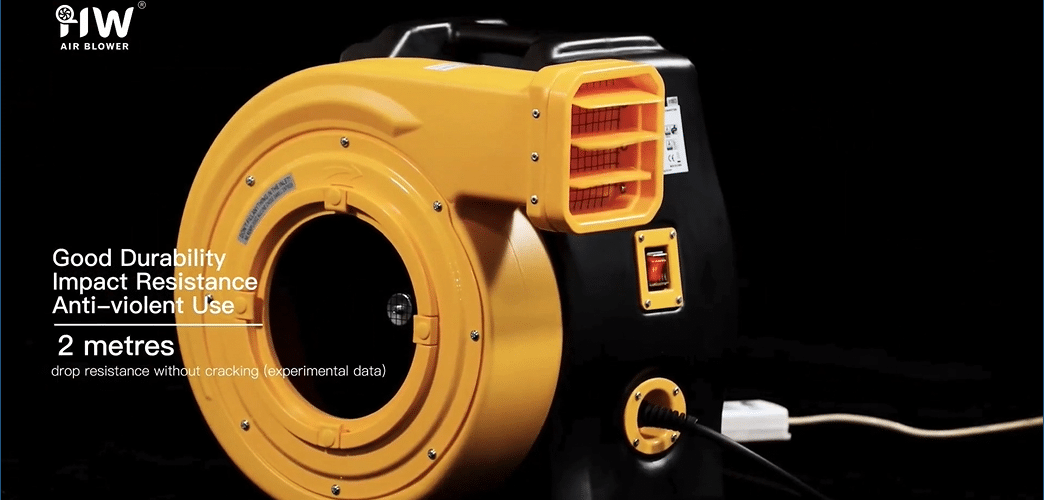
Setting Up Air Blowers for Large Inflatable Structures in Cold Weather
Operating air blowers for large inflatable structures in cold weather requires careful setup and additional precautions to ensure reliable performance. Cold temperatures can affect blower efficiency and inflatable stability, so taking the right steps is essential for safe and consistent operation. Here’s a guide to setting up air blowers for large inflatables during Canada’s colder months.
1. Choose the Right Blower Model for Cold Conditions
For large inflatables in cold weather, select a heavy-duty blower with a powerful motor that can maintain steady airflow even as temperatures drop. Certain models are designed to operate efficiently in colder environments, providing the consistent air pressure necessary to keep large structures stable in challenging conditions. Opt for weather-resistant Huawei blowers, which are engineered for outdoor use and can handle low temperatures effectively.
2. Position Blowers on Insulated Surfaces
Placing blowers directly on cold ground can lead to temperature loss and even motor freezing. Instead, position the blower on an insulated surface like a rubber mat or wooden platform. This extra layer helps protect the blower from the cold ground, preventing internal parts from cooling too rapidly and helping the motor maintain a consistent temperature.
3. Check and Protect Power Sources
Ensure that the blower is connected to a stable power source and consider using a GFCI outlet for added safety. Cold weather can make power cords brittle, so inspect all electrical connections for cracks or fraying before use. If an extension cord is required, use one rated for outdoor, cold-weather conditions to avoid potential power fluctuations that can interfere with blower performance.
4. Monitor Inflation Time
Inflating large structures in cold weather may take longer than usual. Monitor the inflation process closely to ensure that each section of the structure is filling evenly. Cold air can reduce the flexibility of inflatable materials, so gradual inflation may help prevent stress on the seams and fabric. Allow extra time for setup to accommodate this process and ensure that the structure is fully stable.
5. Use Windbreaks to Minimize Heat Loss
Cold winds can cause rapid heat loss from the blower and affect the stability of the inflatable. Set up windbreaks around the blower and inflatable, using barriers like portable fencing or natural obstacles to shield the blower from wind. This helps maintain a more consistent temperature around the blower, improving efficiency and reducing the risk of performance drops due to cold air.
6. Check for Ice or Snow Build-Up
Inspect the blower and surrounding area for any ice or snow buildup that could restrict airflow or impact stability. Clear away any snow from around the blower, and keep the air intake and outlet clear of obstructions. Ice buildup can restrict airflow, causing the blower to work harder, which could lead to overheating or reduced air pressure.
7. Regularly Monitor the Blower’s Temperature
Cold weather can cause the blower motor to work harder, so it’s important to regularly check the blower’s temperature throughout the event. If the blower has built-in temperature regulation features, monitor these to ensure the motor isn’t overworked. For manual checks, feel the housing periodically to make sure it isn’t overheating, which can happen if ice restricts the intake or outlet.
8. Allow for Gradual Deflation After Use
Once the event is over, avoid rapidly deflating the inflatable in cold weather, as sudden deflation can cause the fabric to become brittle. Instead, allow the structure to deflate gradually, which helps protect the material from cracking or tearing. Turn off the blower and monitor the deflation process to ensure the structure collapses evenly.
9. Perform Post-Event Maintenance
After operating the blower in cold weather, perform a quick maintenance check. Clear away any remaining ice, inspect the power cord, and remove any moisture before storage. Ensuring the blower is dry and free of ice helps prevent damage to internal components and prepares the blower for future use.
Conclusion: Reliable Cold Weather Setup for Large Inflatables
Setting up air blowers for large inflatables in cold weather requires extra attention to ensure safe, reliable operation. By choosing the right blower model, protecting power sources, using insulated surfaces, and monitoring temperature, you can keep your inflatables secure and stable even in challenging conditions. These steps help maintain blower performance and ensure that your inflatable structures remain safely inflated throughout the event.
With the proper setup, Huawei air blowers can provide dependable service during cold-weather events, ensuring client satisfaction and safe operation for every rental.